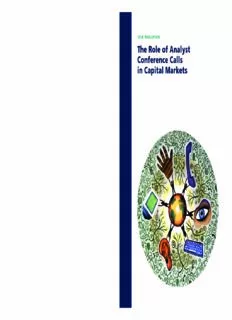
The Role of Analyst Conference Calls in Capital Markets PDF
Preview The Role of Analyst Conference Calls in Capital Markets
Pagina 1 B&T29883 omslag roelofsen Scale: 100% TanHnEMo RuaOnncyLe Efmi rOemnFst A.c oINnn AdthLuYecstSe aT c cCaolOlnsNf, eFmrEeanRncEaeNg ceCamEll e CwnAtit LhdL iasScn uIasNlsy esCstA st PhshIeTo AcrotLlmy M palfAetteRerKd tE hqTeuS aqrutaerr,t earnlyd eaanranliynsgtss w.haveka.nl) 190 TERhIK eRO ERLOoFSlEeN of Analyst w mvcacuaoinsralneatlyTsfutl uy,eha assmlil.ssiul ny kpgrgT ogeaqh rselueawesa neat aseiarnytconlisgahoua r lnstlgisyh vshess.aet eitos Dd w sccsuakase em hlmbml socpto awoaalrres resket S ee EludottiCg hs.fr eh aeArfttaeuc cqgooltm urnnfiooioaf rnwerten hrsmiaie.neng neTv gencrhe roetnsesls t u e,os mwctrcoau obdhfldln eeo ycfrc oe itiospnnrrieafrvfo onneenivncrss-eecivtmdrni egiecacpsaa ektttlo isllenics,rt sa gst i ll.wnalelsin sh ttaiiyhnenl yen cfcs oosatU rn ipmnnfiefi tatooraeternlid eon m cnccSaeo ats nraictknfsatee, el lrtsstes h a naaenbcrrideeyer w.b-en-t.nl) Print: Haveka (w ERIK ROE Cino Cnafeprietanlc eM Caarkllests ent-ERIM ptaTitftnhhahbhrfveeaeoiosoCs t ui r ieunonmstnsrfel flt oitaoletnualtrhr-ctdtimsmteoaiyiioidnanva rnteeg tbai ni lioaoylabuesn,rnnly oeee t a-ed heslanasiysnedc svhssvtoseitoeiirefsv ro wc t oerldsaneinls enoyms imns a uetpn tlelhoynstronasno.sttt t,teb . ps v b e rIoomudwnofit cva i baetttinhdhy h astee ehegar ieceinereto sirvaeurpsnil ms dyetdersescu fut tnsussi etecnl.tu n e o bHdce tetoeyshihln,snnie ea tfcem afteevs ncra,ci o edgoyotnneih nnbbcfne feelecec er oierr ecnene aantinsfslesceltsc srererepa i etct rcnshctcet.eaacias vdelletAlli s nt bmc ytttawye hoolo dliai vsrtf ne dh ltietas nh ha sla asyertanttnus no atc di lcaniyayaknlfstl b oc ttsmeoeesrunm numagerttragpini kcvtetrehtie isohtcetstsohnes.s. Design & layout: B&T Ontwerp en advies (ww LOFSEN- The Role o m f A e n g a a ERIM ly n The Erasmus Research Institute of Management (ERIM) is the Research School (Onder - st a zoek school) in the field of management of the Erasmus University Rotterdam. The C M o founding participants of ERIM are Rotterdam School of Management (RSM), and the n f f Erasmus School of Econom ics (ESE). ERIM was founded in1999 and is officially accred ited e o r by the Royal Netherlands Academy ofArts and Sciences (KNAW). The research undert aken e ute binyt eErRfiIrMm riselafoticounsse,d a nodn ittsh be umsin anesasg epmroecnets soesf itnh teh efiirrm in tienr ditesp eenndveirnotn cmoennnte, ctitiosnisn.t ra- and nce C tit adv Tahneceodb jedcotcivtoer aolf EpRroIMg r iasm tom cea rirny oRuest efairrscth r aitne Mreasenaargcehm ine nmt.a nWagitehm ine nEtR, IaMn,d otov eorfftehrr aene all s s n hundred senior researchers and PhD candidates are active in the different research pro- i n I grammes. From a variety of academ ic backgrounds and expertises, the ERIM commun ity is C h united in striving for excellence and working at the foref ront of creating new business a rc knowledge. pi a ta e l s M e a R r k s e u ts m s a r E ERIM PhD Series Research in Management Erasmus Research Institute of Management - ERIM Tel. +31 10 408 11 82 Rotterdam School of Management (RSM) Fax +31 10 408 96 40 E Erasmus School of Economics (ESE) E-mail [email protected] R P.O. Box 1738, 3000 DR Rotterdam Internet www.erim.eur.nl I M The Netherlands The Role of Analyst Conference Calls in Capital Markets The Role of Analyst Conference Calls in Capital Markets Derolvanconferencecallsmetanalisten inkapitaalmarkten PROEFSCHRIFT terverkrijgingvandegraadvandoctor aandeErasmusUniversiteitRotterdam opgezagvandeRectorMagnificus Prof.dr.H.G.Schmidt envolgensbesluitvanhetCollegevoorPromoties. Deopenbareverdedigingzalplaatsvindenop 27januari2010om13.30uur door ErikMichelRoelofsen geborente’s-Gravenhage Promotoren: Prof.dr.G.M.H.Mertens Prof.dr.L.G.vanderTasRA OverigeLeden: Prof.dr.M.N.HoogendoornRA Prof.dr.C.B.M.vanRiel Prof.dr.P.G.J.Roosenboom ErasmusResearchInstituteofManagement–ERIM RotterdamSchoolofManagement(RSM) ErasmusSchoolofEconomics(ESE) ErasmusUniversityRotterdam Internet:http://www.erim.eur.nl ERIMElectronicSeriesPortal: http://hdl.handle.net/1765/1 ERIMPhDSeriesinResearchinManagement,190 ReferencenumberERIM:EPS-2009-F&A ISBN978-90-5892-228-1 ©2010, ErikRoelofsen Design:B&TOntwerpenadvieswww.b-en-t.nl Print:Havekawww.haveka.nl All rights reserved. No part of this publication may be reproduced or transmitted in any form or by any means electronic or mechanical, including photocopying, recording, or by any information storage and retrieval system, without permission in writing from the author. ©2010,ErikRoelofsen Contents Preface.................................................................................................................................xi 1 Introduction.............................................................................................................1 1.1 Theuseofanalystcalls..............................................................................................1 1.2 Subjectofthisresearch..............................................................................................4 2 Whatmakesconferencecallsuseful?....................................................................7 2.1 Introduction...............................................................................................................7 2.2 Priorliteratureandhypothesisdevelopment..........................................................11 2.2.1 Managementdisclosuresduringthepresentationanddiscussionperiodlength.11 2.2.2 Contentofthepresentationanddiscussionperiodlength...................................14 2.3 Dataandvariablemeasurement.............................................................................15 2.3.1 Sampleselection..................................................................................................15 2.3.2 Dependentvariables............................................................................................21 2.4 Relationbetweenpresentationanddiscussionperiodlengths................................31 2.4.1 Measuringabnormalpresentationlength............................................................31 2.4.2 Theeffectofabnormalpresentationlengthondiscussionlength.......................40 2.4.3 Therelationbetweenlengthandinformation......................................................43 2.5 Relationbetweenpresentationcontentanddiscussionperiodlength....................52 2.5.1 Measuringabnormalfinancialandforward-lookingdisclosures........................52 2.6 The effect of abnormal financial and forward-looking disclosures on discussion length 55 2.7 Conclusions.............................................................................................................59 3 Disclosureofintangibleassetinformationinconferencecalls..........................61 3.1 Introduction.............................................................................................................61 3.2 Earningsconferencecalls.......................................................................................63 3.3 IntangibleAssets......................................................................................................65 3.4 Hypothesesdevelopment..........................................................................................67 3.5 Methodology............................................................................................................69 3.5.1 Sampleselection..................................................................................................69 3.5.2 Variables..............................................................................................................73 3.5.2.1 Dependentvariables................................................................................73 3.5.2.2 Independentvariables..............................................................................74 3.5.2.3 Controlvariables......................................................................................82 3.6 Empiricaltests.........................................................................................................83 3.6.1 Informationcontentofintangibleassetdisclosures............................................83 3.6.2 Aredisclosures“sticky”?.....................................................................................87 3.6.3 Domanagerslearnfromthediscussionportion?................................................91 3.7 Discussionandconclusions.....................................................................................94 4 Doanalystsvoicetheirtruebeliefsinconferencecalls?....................................97 4.1 Introduction.............................................................................................................97 4.2 Priorresearchandhypothesisdevelopment...........................................................99 4.3 Dataandvariablemeasurement...........................................................................102 4.3.1 Sampleselection................................................................................................102 4.3.2 Dependentvariables..........................................................................................105 4.3.2.1 Optimismmeasure.................................................................................105 4.3.2.2 Returnduringthediscussion.................................................................111 4.3.3 Explanatoryvariables........................................................................................111 4.3.4 Controlvariables................................................................................................113 4.4 Empiricaltests.......................................................................................................116 4.4.1 Isanalystoptimisminformative?......................................................................116 4.4.2 Effectofbadnewsonreflectionofanalysts’truebeliefs.................................117 4.4.3 Effectofinstitutionalholdings..........................................................................121 4.5 Conclusions...........................................................................................................124 5 Conclusion............................................................................................................127 References.........................................................................................................................131 Summary..........................................................................................................................139 Samenvatting....................................................................................................................143
Description: